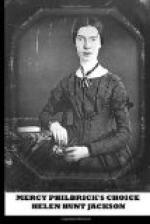“That’s Stephen’s last notion. He’s never satisfied without he’s sticking up suthin’ new or different,” they would say, as they called attention to some new picture or shelf or improvement in the house. “It’s all tom-foolery. Things was well enough before.” But in their hearts they were secretly a little elate, as in latter years they had come to know, by books and papers which Stephen forced them to hear or to read, that he was really in sympathy with well-known writers in this matter of the adornment of homes, the love of beautiful things even in every-day life.
A little more than a year before the time at which our story begins, Stephen’s father had died. On an investigation of his affairs, it was found that after the settling of the estate very little would remain for Stephen and his mother. The mortgage on the old Jacobs house was the greater part of their property. Very reluctantly Stephen decided that their wisest—in fact, their only—course was to move into this house to live. Many and many a time he had walked past the old house, and thought, as he looked at it, what a bare, staring, hopeless, joyless-looking old house it was. It had originally been a small, square house. The addition which Billy Jacobs had made to it was oblong, running out to the south, and projecting on the front a few feet beyond the other part. This obtrusive jog was certainly very ugly; and it was impossible to conceive of any reason for it. Very possibly, it was only a carpenter’s blunder; for Billy Jacobs was, no doubt, his own architect, and left all details of the work to the builders. Be that as it may, the little, clumsy, meaningless jog ruined the house,—gave it an uncomfortably awry look, like a dining-table awkwardly pieced out for an emergency by another table a little too narrow.




